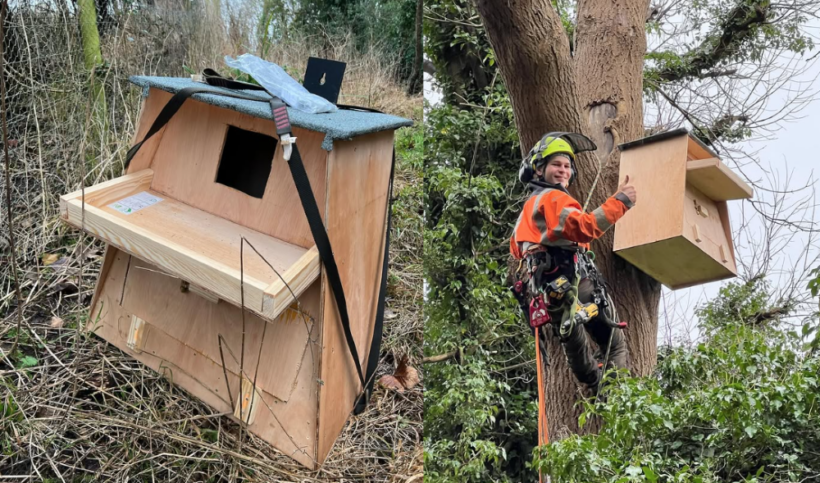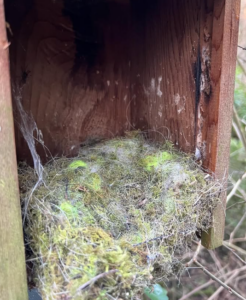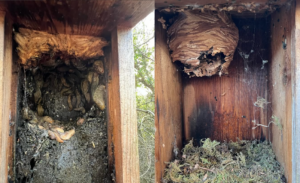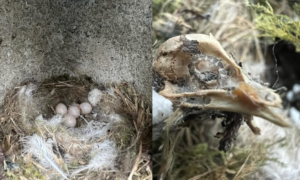‘If you build it, they will come’
Tuesday 18th February 2025

(click the audio file if you would prefer to listen to this blog)
I’m lucky to have a prime office position here at the Science Oxford Centre, with window views of the woodland and ponds, including our small bird feeding station, where I have seen plenty of action recently (watch the video clip below).
We do what we can to help our local avian population. In addition to our bird ‘café’, we provide homes and have over fifty bird boxes in our current offering, available to residents on a first-come, first-served basis!
All homes require some maintenance. Every winter, I spend a couple of days checking each and every box, making any necessary repairs, and removing old nests – and with them, any invertebrate pests that might also have made them home.
Amazing interiors
I often marvel at some of the stunning creations I find woven out of an assortment of local building materials, and I think of the effort that went into them. Sadly, there is also sometimes evidence of human’s lack of respect for the outdoors, with items of litter incorporated into the weave.

Uninvited guests
Not every box is quite so inspirational, with other occupants vying for these desirable locations. The worst are when a cornucopia of slugs has taken over once the birds have moved on. Like unruly squatters, they are sometimes found filling the previously dry and spacious box to the brim with slime and associated decay.

Signs of life and lives not lived
Occasionally, I find a few beautiful tiny eggs remaining dormant in a nest, unhatched, perhaps because they were infertile, damaged, or exposed to temperatures that were too cold or hot while being incubated. Sometimes there is evidence of tragic misfortune, with skeletal remains of the hatched fledglings. Who knows what disaster may have befallen the birds – perhaps the parents were scared away by predators and had to abandon their young, or worse.

The quantity of eggs in a clutch varies from species to species, but numbers can be as high as 12 or more. Ecologically, the loss of a few eggs or even fledglings is not a complete disaster. Because parent birds actively clear up eggshells from hatched eggs, sometimes consuming them for their calcium, or otherwise them away from the nest, the absence of broken shells is a good sign. This suggests that the parents continued to visit and some of the clutch will have hatched and fledged successfully, ensuring the population numbers remain high.
National Nestbox Week
This week is national ‘National Nestbox Week’, staged to highlight the forthcoming bird nesting season. The exact timing of bird nesting is highly variable depending on species, geographical location, climatological conditions and even the experience of the birds in question. In the UK, it is generally accepted to be between March and September; between these months, it is important to minimise disturbance in sites where birds might be frequenting.
Uniquely styled
Here at Science Oxford we’ve used a variety of nestbox designs to appeal to birds from tiny long-tailed tits all the way up to big tawny owls. Many were made and installed by our friend Vic Toplisek at Nests for Nature. While some birds are fairly indiscriminate when it comes to nesting locations, others can be quite particular. I recorded an 85% occupancy rate in our boxes last year suggesting they present a very desirable option. We recently unveiled a fine new home specifically with barn owls in mind. This impressive dwelling was made by local volunteer Louie Allen and kindly installed by Ben at Treescape, our local tree surgeons (see feature image).
Make your own nestbox
When you are next exploring or out in the woodlands at one of our Family Days, have a look at how many bird-, bat- and other habitat boxes you can spot. You could even make your own nestbox at home: Find out more at https://www.nestboxweek.com/
Our bird feeders were busy one bright, sunny morning!



